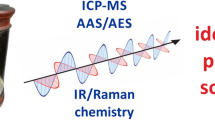Abstract
Chemical analysis of ancient residues of pharmaceutical or cosmetic preparations such as balms or ointments is made problematic by the high complexity of these mixtures, composed of organic and inorganic materials. Consequently, a multi-analytical approach and special caution in the interpretation of the results are necessary. In order to contribute to the improvement of analytical strategies for the characterization of complex residues and to reconstruct ancient medical practices, a replica of a pharmaceutical formulation of the seventeenth century was prepared in the laboratory according to a historically documented recipe. In a round robin exercise, a portion of the preparation was analysed as a blind sample by 11 laboratories using various analytical techniques. These included spectroscopic, chromatographic and mass spectrometric methods. None of the laboratories was able to completely reconstruct the complex formulation, but each of them gave partial positive results. The round robin exercise has demonstrated that the application of a multi-analytical approach can permit a complete and reliable reconstruction of the composition. Finally, on the basis of the results, an analytical protocol for the study of residues of ancient medical and pharmaceutical preparations has been outlined.








Similar content being viewed by others
References
van Keulen H (2009) Gas chromatography/mass spectrometry methods applied for the analysis of a round robin sample containing materials present in samples of works of art. Int J Mass Spectrom 284:162–169
Barnard H, Ambrose SH, Beehr DE, Forster MD, Lanehart RE, Malainey ME, Parr RE, Rider M, Solazzo C, Yohe RM (2007) Mixed results of seven methods for organic residue analysis applied to one vessel with the residue of a known foodstuff. J Archaeol Sci 34:28–37
Bouchardat A. (1864) Nuovo Formulario Magistrale, 4rd edn., Giuseppe Pedone Lauriel and C. Editori, Palermo and Naples
Prin07 Congresso 2010, Colori e Balsami nell’antichità: Dallo Studio Chimico alla Conoscenza delle Tecnologie in Cosmesi, Pittura e Medicina, Sansepolcro (AR), Italia, 2–3 December 2010
Nuovo Autore called “il Greco” (1641) Secreti Nobilissimi, Ghidini Stamp. del S. Offic. Pavia
Ricettario Fiorentino (1789) Gaetano Cambiagi Stampatore Granducale, Florence
Farmacopea Hispanica, 4rd edn. (1826) Excudebat Societas Typogr. Classicorum Italiae Scriptorum, Sumptibus Editoris, Milan
Occo A. (1597) Farmacopea Augustana. Bernardino Barozzi (ed), Venice
Binz C (1872) Abrégé de Matière Médicale et de Thérapeutique. Librairie Germer Baillière, Paris
Cotte M, Checroun E, Susini J, Dumasc P, Tchoreloff P, Besnard M, Walter Ph (2006) Kinetics of oil saponification by lead salts in ancient preparations of pharmaceutical lead plasters and painting lead mediums. Talanta 70:1136–1142
Kotulanová E, Bezdicka P, Hradil D, Hradilová J, Svarcová S, Grygar T (2009) Degradation of lead-based pigments by salt solutions. J Cult Herit 10:367–37
Lee PC, Meisel D (1982) Adsorption and surface-enhanced Raman of dyes on silver and gold sols. J Phys Chem 86:3391–3395
Lau D, Livett M, Prawer S (2008) Application of surface-enhanced Raman spectroscopy (SERS) for the analysis of natural resins in artwork. J Raman Spectrosc 39:545–552
Edwards HGM, Falk MJ (1997) Fourier transform Raman spectroscopic study of ancient resins: a feasibility study of application to archaeological artefacts. J Raman Spectrosc 28:211–218
Riedo C, Scalarone D, Chiantore O (2010) Advances in identification of plant gums in cultural heritage by thermally assisted hydrolysis and methylation. Anal Bioanal Chem 396:1559–1569
Colombini MP, Modugno F, Ribechini E (2005) Organic mass spectrometry in archaeology: evidence for Brassicaceae seed oil in Egyptian ceramic lamps. J Mass Spectrom 40:890–898
Tchapla A, Mejanelle P, Bleton J, Goursaud S (2004) Characterisation of embalming materials of a mummy of the Ptolemaic era. Comparison with balms from mummies of different era. J Sep Sci 27:217–234
Bleton J, Tchapla A (2009) SPME/GC-MS in the characterisation of terpenic resins. In: Colombini MP, Modugno F (eds) Organic mass spectrometry in art and archaeologie. Wiley, New York, pp 261–302
Koller J, Baumer U (2006) Ererprobte die seltsamsten Methoden, um Öle zum Malen zu finden. Leonardos Rolle in der frühen italienischen Ölmalerei. In: Syre C, Stege H, Schmidt J (eds) Leonardo, Die Madonna mit der Nelke. München, pp. 155–174, 234–241
Lluveras A, Bonaduce I, Andreotti A, Colombini MP (2010) GC/MS analytical procedure for the characterization of glycerolipids, natural waxes, terpenoid resins, proteinaceous and polysaccharide materials in the same paint microsample avoiding interferences from inorganic media. Anal Chem 82:376–386
Hamm S, Bleton J, Tchapla A (2004) Headspace solid phase microextraction for screening for the presence of resins in Egyptian archaeological samples. J Sep Sci 27:235–243
Kimpe K, Jacobs PA, Waelkens M (2001) Analysis of oil used in Late Roman oil lamps with different mass spectrometric techniques revealed the presence of predominantly olive oil together with traces of animal fat. J Chromatogr A 937:87–95
Romanus K, Poblome J, Verbeke K, Luypaerts A, Jacobs P, De Vosand D, Waelkens M (2007) An evaluation of analytical and interpretative methodologies for the extraction and identification of lipids associated with pottery sherds from the site of Sagalassos, Turkey. Archaeometry 49:729–747
Graig T, Grave P, Glover S (2009) HPLC-MS characterization of adsorbed residues from Early Iron Age ceramics, Gordion, Central Anatolia. New Direction in Archaeological Sciences 28:203–212
Acknowledgements
The Italian National PRIN2007 project and ABOCA s.p.a (Italy) are acknowledged for providing funds.
Author information
Authors and Affiliations
Corresponding author
Additional information
Published in the special issue Analycal Chemistry to Illuminate the Past with guest editor Maria Perla Colombini.
Rights and permissions
About this article
Cite this article
Colombini, M.P., Modugno, F., Gamberini, M.C. et al. A round robin exercise in archaeometry: analysis of a blind sample reproducing a seventeenth century pharmaceutical ointment. Anal Bioanal Chem 401, 1847–1860 (2011). https://doi.org/10.1007/s00216-011-5105-1
Received:
Accepted:
Published:
Issue Date:
DOI: https://doi.org/10.1007/s00216-011-5105-1




